In this blog, we’ll explore how the SIPPS foundational skills program connects to the dyslexia conversation. We’ll also examine characteristics of SIPPS instruction that support students who have reading difficulties including dyslexia.
If you missed the earlier blogs in our dyslexia series, read Part One for a current definition of dyslexia, a discussion of dyslexia in the national literacy conversation, and implications for instruction. Read Part Two for an exploration of best practice in dyslexia instruction; this blog also explains the tenets of structured literacy and advocates for evidence-based instruction in phonological awareness, the alphabetic principle, and decoding.
In the International Literacy Association (ILA)’s Literacy Leader’s Brief titled Meeting the Challenges of Early Literacy Phonics Instruction, systematic and explicit phonics instruction is highlighted as part of comprehensive literacy instruction.
The brief contains many important insights, but the one that stands out most is this statement: “[P]honics instruction is helpful for all students, harmful for none, and crucial for some” (p. 2).
“…phonics instruction is helpful for all students, harmful for none, and crucial for some.”
This statement applies directly to the evidence-based instruction in phonological awareness, the alphabetic principle, and decoding that are essential instructional elements for students with dyslexia. Moreover, the statement emphasizes the importance of effective instruction regardless of whether the student has a diagnosis.
The ILA brief prompted me to take a closer look at the SIPPS program and how it aligns with the following essential instructional elements:
- phonological awareness
- the alphabetic principle
- decoding
- encoding
SIPPS Aligns with the Structured Literacy Framework
With the rise of conversations and legislation around dyslexia, we at Collaborative Classroom have reflected on our own work and how it supports students with dyslexia and other reading difficulties.
The SIPPS program is designed to efficiently close gaps in foundational skills using systematic, explicit instructional routines. In addition, the program aligns with the Structured Literacy framework, which the International Dyslexia Association recommends as best practice in teaching students with dyslexia. You can find a detailed chart illustrating how SIPPS routines align directly with the framework in “Structured Literacy and the SIPPS Program.”
Next we’ll delve deeper into how these SIPPS routines support the critical instructional elements discussed in our previous dyslexia blogs.
How SIPPS Instruction Supports Phonological Awareness
In SIPPS, phonological awareness is taught and reviewed daily using explicit, systematic routines that do not involve print. The activities are sequenced so that they generally increase in difficulty. During this routine, the teacher visually represents units of sound with horizontal lines for phonemes and boxes for words, syllables, and rimes. These visual cues are used as students are prompted to practice oral blending and segmenting. The illustrations below show a routine for segmenting.
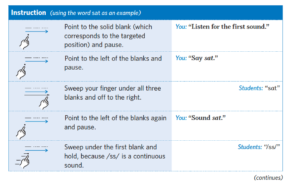

How SIPPS Instruction Supports The Alphabetic Principle
In SIPPS, explicit and systematic instruction ensures that students thoroughly learn spelling-sound relationships. The teacher uses handheld cards to introduce new spelling-sound relationships and to review those taught previously. Students immediately practice new sounds by blending and reading decodable words.
See this example for introducing the sound /s/.
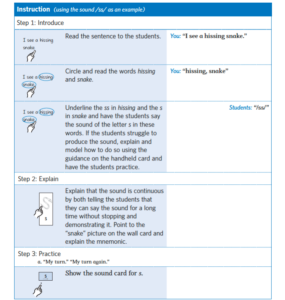
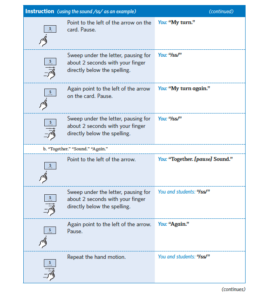
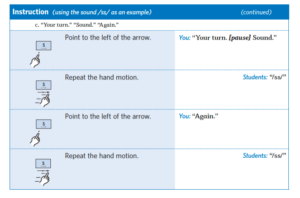
How SIPPS Instruction Supports Decoding
Ample decoding instruction and practice is provided in the SIPPS program. First, students apply new sounds and review sounds as they blend and read decodable words. The Reading a Story routine in each lesson gives students the opportunity to apply what they have learned about sounds in the context of reading connected text. Each lesson includes a new story composed primarily of previously taught spelling-sounds and sight words. These two decoding routines ensure that students transfer discrete skills directly to reading.

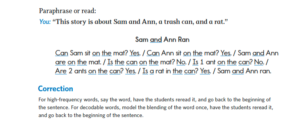
How SIPPS Instruction Supports Encoding
The Guided Spelling routine in each SIPPS lesson provides spelling practice coordinated with decoding instruction. In this routine, students learn strategies they can apply to spelling many words phonetically. The teacher models spelling strategies and helps students write the words successfully. This ensures that from very early on, students understand the reciprocal relationship between the sounds they are learning to decode and their spelling.
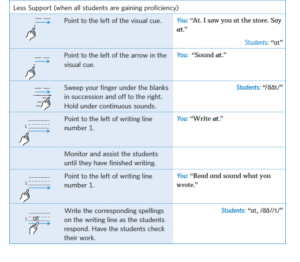
SIPPS Instruction Is Multisensory
In SIPPS, the instruction is multisensory. Students listen to verbal prompts, follow visual cues, and respond chorally in most routines. Students also write during the Guided Spelling routine.
In addition, when needed, teachers have the option to enhance the basic SIPPS routines using guidance from the Intensive Multisensory Instruction for SIPPS Handbook. This manual provides additional multisensory instruction ideas that can be smoothly incorporated into regular SIPPS lessons.
In the example below, the teacher is prompted to use the Segmentation routine with the addition of a visual cue and markers. The enhanced routine includes a “Sound Lines” page and one marker in each circle on the page for each student.

How the SIPPS Program Aligns with the Orton-Gillingham Approach
Across the country, the term Orton-Gillingham in relation to dyslexia instruction is gaining currency. The OG approach was developed in the 1930s by Dr. Samuel Orton and Anna Gillingham as a solution for students with dyslexia and other reading challenges.
The Orton-Gillingham approach is just that: an approach, not a curriculum.
The Orton-Gillingham approach is just that: an approach, not a curriculum. We compared the characteristics of the Orton-Gillingham approach and the SIPPS program. Our findings, documented in “The Orton-Gillingham Approach and the SIPPS Program,” identify the similarities between the OG Approach and SIPPS.
Key Takeaways
Fully understanding dyslexia and other reading difficulties is challenging, and our striving readers may or may not have an official diagnosis.
As educators we cannot, and should not, wait for a diagnosis. Time is of the essence for these young readers. We know that effective reading instruction is key to both prevention and intervention, so let us focus on that first line of defense: consistent, systematic, explicit, and research-based instruction.
Effective reading instruction is key to both prevention and intervention.
At the heart of our conversations are individual children who have unique needs and paths in reading development. We know that consistent, systematic, and explicit instruction will benefit these children; and there is an urgency to ensure all students receive what we know will be “helpful for all, harmful for none, and crucial for some” (ILA, 2019, p.2) in an effort to grow readers who can read the words, understand them, and find joy in reading.
***
Related Reading
Using SIPPS for Dyslexia Intervention: An Interview with Montgomery ISD
